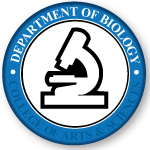Author ORCID Identifier
Document Type
Article
Publication Date
2013
Publication Title
Retrovirology
Volume
10
Issue
1
Abstract
Background: The HIV-1 accessory protein, Nef, is decisive for progression to AIDS. In vitro characterization of the protein has described many Nef activities of unknown in vivo significance including CD4 downregulation and a number of activities that depend on Nef interacting with host SH3 domain proteins. Here, we use the BLT humanized mouse model of HIV-1 infection to assess their impact on viral replication and pathogenesis and the selection pressure to restore these activities using enforced in vivo evolution.
Results: We followed the evolution of HIV-1LAI (LAI) with a frame-shifted nef (LAINeffs) during infection of BLT mice. LAINeffs was rapidly replaced in blood by virus with short deletions in nef that restored the open reading frame (LAINeffsΔ-1 and LAINeffsΔ-13). Subsequently, LAINeffsΔ-1 was often replaced by wild type LAI. Unexpectedly, LAINeffsΔ-1 and LAINeffsΔ-13 Nefs were specifically defective for CD4 downregulation activity. Viruses with these mutant nefs were used to infect BLT mice. LAINeffsΔ-1 and LAINeffsΔ-13 exhibited three-fold reduced viral replication (compared to LAI) and a 50% reduction of systemic CD4+ T cells (>90% for LAI) demonstrating the importance of CD4 downregulation. These results also demonstrate that functions other than CD4 downregulation enhanced viral replication and pathogenesis of LAINeffsΔ-1 and LAINeffsΔ-13 compared to LAINeffs. To gain insight into the nature of these activities, we constructed the double mutant P72A/P75A. Multiple Nef activities can be negated by mutating the SH3 domain binding site (P72Q73V74P75L76R77) to P72A/P75A and this mutation does not affect CD4 downregulation. Virus with nef mutated to P72A/P75A closely resembled the wild-type virus in vivo as viral replication and pathogenesis was not significantly altered. Unlike LAINeffs described above, the P72A/P75A mutation had a very weak tendency to revert to wild type sequence.
Conclusions: The in vivo phenotype of Nef is significantly dependent on CD4 downregulation but minimally on the numerous Nef activities that require an intact SH3 domain binding motif. These results suggest that CD4 downregulation plus one or more unknown Nef activities contribute to enhanced viral replication and pathogenesis and are suitable targets for anti-HIV therapy. Enforced evolution studies in BLT mice will greatly facilitate identification of these critical activities.
Recommended Citation
Watkins R.L., Zou W., P.W. Denton, J.F. Krisko, J.L. Foster, and J.V. Garcia. 2013. In vivo analysis of highly conserved Nef activities in HIV-1 replication and pathogenesis. Retrovirology, 10.1186/1742-4690-10-125.


Comments
© 2013 Watkins et al.; licensee BioMed Central Ltd. This is an open access article distributed under the terms of the Creative Commons Attribution License (http://creativecommons.org/licenses/by/2.0), which permits unrestricted use, distribution, and reproduction in any medium, provided the original work is properly cited.
https://doi.org/10.1186/1742-4690-10-125